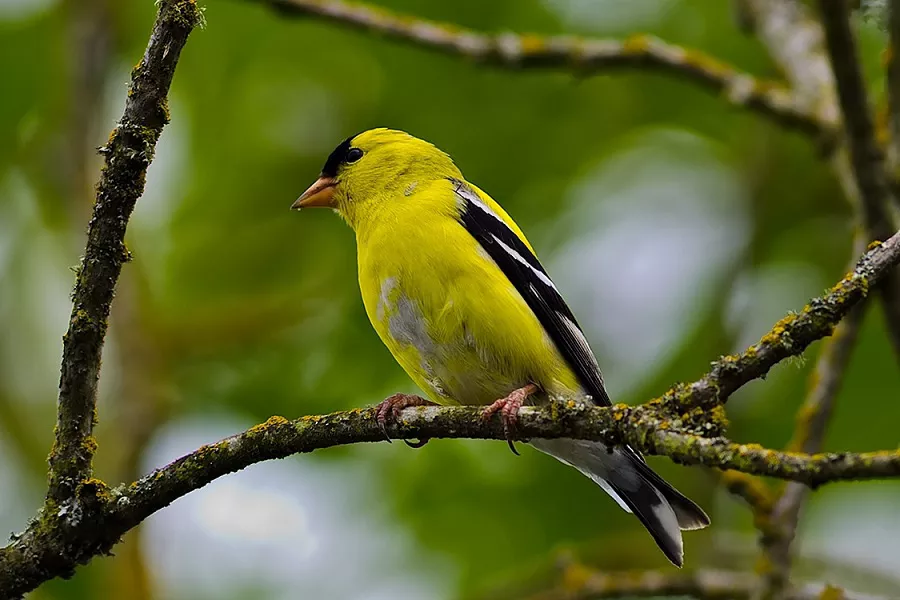Goldfinches are small, vibrant birds known for their bright yellow plumage and delightful song. These charming creatures can be found in various regions across the globe, including North America, Europe, and Asia. One of the most intriguing aspects of goldfinches is their nesting behavior. In this article, we will explore where goldfinches nest, their preferred habitats, and the factors that influence their nesting choices.
Nesting Habits of Goldfinches
Goldfinches are late-nesting birds, typically beginning their breeding season in late spring or early summer. Unlike many other bird species, goldfinches do not build their nests in tree cavities or on branches. Instead, they prefer to construct their nests in shrubs and trees, particularly those with dense foliage. The nests are usually built by the female goldfinch, using a combination of plant fibers, grasses, moss, and spider silk. These materials create a sturdy and well-insulated structure.
Preferred Habitat
Goldfinches have specific preferences when it comes to choosing their nesting sites. They are commonly found in open areas such as meadows, fields, gardens, and woodland edges. Goldfinches are particularly attracted to areas with abundant food sources, including thistle plants, sunflowers, and other types of seed-bearing plants. These plants provide both nesting materials and a reliable food supply for the adult birds and their offspring.
Factors Influencing Nesting Choices
Several factors influence the nesting choices of goldfinches:
a. Food Availability: As mentioned earlier, goldfinches are highly dependent on seed-bearing plants for their diet. Therefore, they tend to select nesting sites near areas with an ample supply of seeds. This ensures that they have easy access to food during the nesting period.
b. Vegetation Density: Goldfinches prefer nesting in areas with dense vegetation, as it provides them with protection from predators and shelter from the elements. Shrubs and trees with thick foliage offer a safe environment for building nests and raising their young.
c. Proximity to Water: Goldfinches are attracted to nesting sites near water sources such as ponds, streams, or rivers. These locations provide an additional food source in the form of insects and also offer opportunities for bathing and drinking.
d. Predator Avoidance: Goldfinches are cautious birds and choose nesting sites that minimize the risk of predation. They often select locations that are well-hidden or difficult for predators to access, such as dense shrubs or thorny bushes.
Nesting Behavior
Goldfinches exhibit interesting nesting behavior that sets them apart from other bird species:
a. Colonial Nesting: While goldfinches are generally solitary birds, they sometimes engage in colonial nesting. This means that multiple pairs of goldfinches may build their nests in close proximity to one another. Colonial nesting can provide benefits such as increased protection against predators and shared vigilance.
b. Renesting: Goldfinches have been observed to renest during a single breeding season. If a nest fails due to predation or other reasons, the female goldfinch will quickly construct a new nest and lay another clutch of eggs. This behavior allows them to maximize their reproductive success.
Conservation Considerations
Understanding the nesting preferences of goldfinches is crucial for their conservation. Here are some considerations to promote their nesting habitats:
a. Plant Native Species: Planting native seed-bearing plants, such as thistles and sunflowers, can attract goldfinches to your garden or local area. These plants not only provide food but also serve as potential nesting sites.
b. Maintain Natural Vegetation: Preserve or create areas with dense vegetation, including shrubs and trees, to provide suitable nesting habitats for goldfinches. Avoid excessive pruning or clearing of these areas during the breeding season.
c. Provide Water Sources: If possible, incorporate water features like birdbaths or small ponds near potential nesting sites. These water sources attract insects and offer goldfinches an additional food supply.
d. Avoid Pesticides: Minimize the use of pesticides in your garden or surrounding areas, as they can harm goldfinches directly or indirectly by reducing their food sources.
Do Goldfinches Migrate?
Yes, goldfinches do migrate. However, the extent and pattern of migration can vary depending on the specific species of goldfinch and their geographic location.
In North America, the American goldfinch (Spinus tristis) is a well-known migratory bird. During the breeding season, American goldfinches are found in northern parts of the United States and Canada. In the winter, they migrate southward to warmer regions, including parts of the southern United States and Mexico.
The European goldfinch (Carduelis carduelis) is another species that undergoes seasonal migration. European goldfinches breed in Europe and parts of western Asia. Some populations migrate southward during the winter months to escape colder temperatures, while others may remain in their breeding range year-round if conditions are favorable.
It’s important to note that not all goldfinch species migrate. For example, the Lesser Goldfinch (Spinus psaltria) in North America is a resident bird, meaning it does not undertake long-distance migrations and stays in its breeding range throughout the year.
Migration patterns can also be influenced by factors such as food availability, climate, and habitat changes. Therefore, the specifics of goldfinch migration can vary among different species and populations.
See Also: When Do Goldfinches Migrate? (Revealed!)
Conclusion
Goldfinches are fascinating birds that exhibit unique nesting behavior. By understanding their preferred habitats and nesting choices, we can take steps to support their conservation efforts. Creating suitable environments with abundant food sources, dense vegetation, and proximity to water can help ensure the survival and well-being of these delightful creatures. Let us appreciate and protect the nesting habitats of goldfinches, allowing them to thrive and enchant us with their beauty and melodious songs.


 Facebook
Facebook  Instagram
Instagram  Youtube
Youtube 